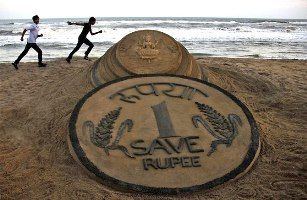 Financial inclusion is back in the limelight after Prime Minister Narendra Modi announced the launch of Pradhan Mantri Jan Dhan Yojana -- an initiative to bank the poor -- in his Independence Day speech.
Financial inclusion is back in the limelight after Prime Minister Narendra Modi announced the launch of Pradhan Mantri Jan Dhan Yojana -- an initiative to bank the poor -- in his Independence Day speech.
The new scheme promises a bank account, a debit card and an insurance cover of Rs 100,000 for poor families.
But many believe that including the financially excluded will continue to remain an unsolved puzzle, at least for now, as problems are plenty, with very few credible solutions in sight.
Indian banks have been struggling for decades to make financial inclusion commercially viable.
The nationalisation of banks in 1969 and the thrust on branch building that followed were attempted at promoting financial inclusion.
In recent years, the Reserve Bank of India adopted a more structured approach directing all state-run and private sector banks to submit a board-approved, three-year financial inclusion plan.
It started in April, 2010, and banks were asked to prepare another three-year FIP for the period 2013-16.
Lenders were asked to design self-set targets in respect of opening rural brick-and-mortar branches, hiring business correspondents, covering un-banked villages and offering financial products such as basic savings bank deposit accounts, kisan credit cards and general credit cards.
Yet, more than 40 per cent of the country’s 1.2 billion people continue to remain financially excluded.
A senior banker with a public sector bank, said, requesting anonymity: “It is not that banks have not made any progress in financial inclusion.
“But due to lack of awareness, low financial education and procedural hassles, many still prefer to borrow money from informal sources like money lenders.
“Also, despite the rapid expansion, the number of bank branches in the country is still inadequate.”
He added that creating a bank account will not necessarily ensure financial inclusion as many of these accounts turn dormant within months after being opened.
A survey on financial access in 2011 revealed that India had 10.6 branches and 8.9 automated teller machines per 0.1 million population.
Compared to this, China had 23.8 branches and 49.6 ATMs, while Brazil had 46.2 branches and 119.6 ATMs per 0.1 million people.
To address the proverbial last-mile problem, banks have turned to information and communication technologies and engaging business correspondents to expand their reach.
But it has not been smooth sailing so far, with reports surfacing of devices like hand-held machines -- crucial to the success of this model -- not properly functioning in many areas of the country.
“Connectivity remains an issue in many rural villages,” admitted a senior executive with a large private sector bank.
The government also noted the challenges in a recent communication to banks on financial inclusion.
“Even though the financial inclusion programme was implemented, it was observed that
“Many of the accounts remained un-transacted.
“The technology and connectivity issues also hampered the implementation.” the government said, adding, ‘Even though financial literacy and credit counselling’ were important aspects of financial inclusion, they were not included.
The limited number of financial services players also impedes the progress of financial inclusion.
Shinjini Kumar, leader, banking and capital markets at PwC India, said: “We need more players in the financial ecosystem to be able to achieve the programmes that are being announced. The supply side may not be able to match the diversity.”
With stress on profitability, mounting bad loans and need for higher capital, banks are now wary of unbridled expansion of their services in deeper geographies.
An executive director of a large private bank said it will take more time for its bank branches in the rural regions to turn commercially viable.
However, the bank continues to expand its footprint in these areas, as it allows the lender to open more branches in more profitable metro centres.
(RBI has decided to incentivise banks that expand their network in deeper geographies by permitting them to open more branches in Tier-1 centres.)
“This is a chicken-and-egg situation.
“You have to start somewhere. . . As a bank one has to start with this opening bank account.
“These bank accounts may not immediately become viable but over a period of time we expect them to be, as and when government money starts moving through these accounts,” the banker said.
The early progress in financial inclusion, however, has been encouraging despite the challenges.
Between April 2010, and March 2013, banking outlets in villages had increased to 268,454 from 67,694.
Close to 7,400 rural branches were opened and nearly 109 million BSBD accounts were added.
Also, around 9.48 million farm sector households and 2.24 million non-farm sector households were included leading to higher disbursement of small entrepreneurial loans.
Apart from the government’s push and regulatory requirement for priority sector lending, increased competition in metro centres has also persuaded banks to explore opportunities in rural regions.
Lenders are planning innovative ways to make their rural banking profitable.
For instance, a large sugar company, which has mills in Maharashtra and Karnataka, employs marginal farmers during the harvest season for supply of sugarcane.
These farmers need money for sowing seeds.
A small private bank, which has strong presence in these geographies, has started offering these farmers loans to help them deliver the contracts to the sugar company.
This allowed the bank to develop a good relationship with the company, which has now started banking with it for its corporate credit requirements.
“We are leveraging on financial inclusion drive to source other businesses for the bank,” said a banker.











